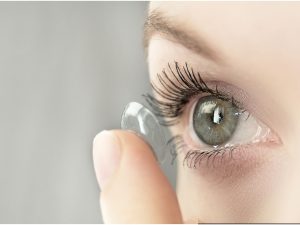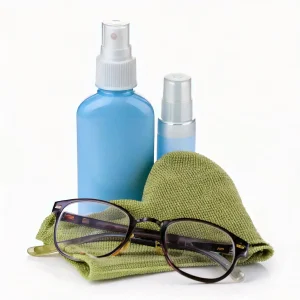Why Glasses Fog Up
Foggy glasses can be a major hassle, particularly in outdoor sports like skiing where you need full visibility. Fogging occurs when lenses are much colder or warmer than the air around them. That temperature difference is what causes moisture to condense on the outside.
This is especially true in extreme cold, such as in winter, when your glasses get very cold, below your body temperature. The cumulative effect is a foggy layer that can seriously impair your vision and ruin your day.
Causes of Foggy Glasses
Fogging occurs when moisture condenses on the surface of lenses. This occurs when warm, humid air from your breath or skin comes in contact with the cool surface of your lenses. Wearing a mask can increase this problem.
That warm air you breathe out goes up into the cold lenses, and since the warm air is wetter, it condenses on the lenses, fogging them up. America’s medical heroes, those who wear both glasses and masks, have been dealing with original glass fog-up for ages.
Most of them depend on gimmicky hacks to combat the annoyance of fogging lenses. Having a proper fit is key to minimizing fogging. If your glasses don’t fit well, they can leave openings on your face.
These gaps allow warm air to come into contact with the lenses, which is what fogs them up. This is especially true in sport, where a snug fit that doesn’t slip is the name of the game. The American Academy of Ophthalmology adds that properly fitted sports glasses can prevent 90 percent of serious eye injuries.
They make a strong case for why we should put safety first—right next to performance.
Factors Contributing to Fogging
There are a few different reasons why glasses fog up. Temperature changes are one of the biggest culprits, like in winter when glasses often get colder than the air around them. Humidity levels have a profound effect on a space.
Higher humidity means that there is more moisture in the air, increasing the likelihood of condensation developing on lenses. Your mask, while it may seem like the obvious culprit, is only half of the equation.
How your glasses fit and what their lenses are made of make a difference. Lack of protective eyewear doubles the rate of sports-related eye injuries. In the US, nearly 30,000 of these incidents occur annually.
It’s a wasted opportunity—stopgap solutions aside, a well-designed pair of glasses is the world’s clearest window. It further improves safety by more than doubling the likelihood that someone injured survives.

Effective Methods to Prevent Fogging
Fogging can be an annoying nuisance for glass wearers, even more so in humid or cold conditions. Here are our best methods to prevent fogging, so you can enjoy clear lenses and an unobstructed view.
1. Wash Glasses with Soap
Wash your glasses with soap and water. This is probably one of the easiest and most cost-effective solutions. The soap creates a very thin film on the lenses, which serves as a protective barrier against fogging.
First, take a drop or two of liquid soap and rub it on the lenses. Next, rub them lightly and wash with warm water. Stay away from soaps containing lotions, they will cause streaks. This easy technique is a quick fog prevention fix that takes just minutes to do each day.
2. Apply Shaving Cream
Another common household item that works great at preventing fog is shaving cream. First, put a small amount of shaving cream on each lens.
Apply and distribute it evenly, then wipe off with a soft cloth. It forms a protective barrier that prevents moisture from collecting. Athletes who wear glasses during high-adrenaline sports swear by this technique. It gives them a simple, quick fix that works.
3. Use Baby Shampoo
Baby shampoo is another effective, albeit less savory, fog prevention solution. Like soap, a little baby shampoo will make a thin film on your lenses that stop fogging up from moisture condensation.
Just add a drop to each lens, smear across the surface and rinse with warm water. It’s gentle enough for sensitive skin and allergy-prone individuals.
4. Try Anti-Fog Spray or Wipes
Applying anti-fog sprays or wipes is a simple, affordable solution. These products are specially made to prevent fogging and are simple to use.
Just spray or rub in the solution on your lenses and allow to dry. This technique is the favorite among professionals, due to the all-weather protection it offers. Fog-fighting products, such as FogStop or dispensable fog-killing wipes, are sure to be familiar to anyone who has worn safety glasses.
5. Consider Anti-Fog Lenses
If you’re looking for a long-term solution, invest in anti-fog lenses. At Premier Optical, we have the latest technology to get you anti-fogging, clearer vision lenses.
These lenses are especially helpful for people who often move quickly between indoor and outdoor spaces. The Raleri Ripper Offroad Goggles and SL Nordik Viking Heated Ski Goggles both use specialized lenses. They help make sure you keep the clear vision you’re used to from fogging.
6. Maintain Clean Eyewear
Maintaining the cleanliness of your eyewear will help with fogging prevention. Dust, dirt, and finger smudges can create areas for moisture collection that leave you fogged up.
To maintain maximum anti-fogging performance, clean your glasses regularly with a microfiber cloth and an appropriate cleaning solution. Properly maintained eyewear not only stops fogging but provides you with the best visual experience.
Adjust Face Mask to Reduce Fogging
Although wearing a mask is now as second nature as putting on a seatbelt, fogged-up eyeglasses are an all-too-frequent consequence. At Premier Optical, we understand the importance of having clear vision. That’s why we’ve put together some practical tips to help you fog this problem out!
Ensure Proper Mask Fit
A close fit is essential to avoiding fogging. Properly fitted masks direct less warm air up toward your glasses. The Centers for Disease Control (CDC) recommends a modification called the “knot and tuck” method to improve fit.
This may include adjusting the fit around your nose and chin and knotting the ear loops or tucking in extra material. This approach helps keep the mask snug against your face, reducing potential airflow leaks.
Place Glasses Over Mask
The other method for preventing glasses fogging is to set your glasses on top of your mask. This way, you form a seal that pushes warm air away from your lenses. It’s a minor adjustment, but it improves the experience enough that it’s worth it.
If your glasses still fog up, try wearing them a little lower on your nose to create space for airflow.
Add a Nose Bridge to Mask
Adding a nose bridge will improve the fit of your mask too. Some masks may have adjustable nose wires, but if yours doesn’t, you can add one yourself. This will help the mask seal against your nose, drastically cutting down on fogging.
Even an extra adhesive strip or a Band-Aid goes a long way! They do a great job of sealing gaps and preventing warm air from escaping up and out.
Seal Mask with Tape or Adhesives
If you’re looking for a more permanent fix, you can try applying tape across the top of your mask. Adhesives offer additional reinforcement as well, holding your mask in place securely.
Products such as sports tape or other skin-friendly adhesives may be employed to help seal the mask. This stops the warm air from escaping and fogging your lenses.
If Band-Aids aren’t your jam, there are plenty of adhesive alternatives that do the trick just as well.
Use a Tissue Inside Mask
Then, slide it under your mask over the top of your nose. This hack towel dries your shield, making fog much less likely to happen. This is because the tissue serves as a barrier, absorbing the moisture before it ever makes it to your lenses.
At Premier Optical, we are dedicated to providing innovative solutions that make your eyewear experience even better. Our prescription glasses come with scratch-resistant, anti-reflective, and superhydrophobic treatments, blocking 100% of UVA and UVB rays for optimal clarity and protection.

Quick Solutions for Unexpected Fogging
We know dealing with fogged glasses is a genuine pain — particularly when you’re going about your business with flair and finesse. At Premier Optical, we understand how important it is to see clearly. That’s why we provide easy solutions to prevent your glasses from fogging, so you can keep that great look you always sport!
Downward Breathing Technique
If you’re looking for quick solutions to combat unexpected fogging, breathing techniques probably aren’t the first solution that comes to mind. When these techniques are tried they can be surprisingly effective!
Exhaling downwards helps to keep your lenses fog-free, as it directs the warm air away from your lenses. This quick fix can go a long way in preventing fogging, especially when used alongside anti-fog treatments.
For a more high-tech solution, consider the SL Nordik Viking Heated Ski Goggles. Their heated lenses eliminate fogging, meaning you’ll have a crystal-clear field of view even in the worst conditions.
Wear Contact Lenses
Making the switch to contact lenses is another great alternative for people tormented by fogged up eyewear. Contact lenses are designed to prevent fogging, so you can enjoy movement and freedom with clear sight without any interruptions.
Innovative brands such as 7Eye by Panoptx provide with their patented AirShield foam, preventing fog buildup indoors and outdoors, in any climate. This newfound freedom can feel downright amazing when you’re playing sports.
In fact, 90% of these serious eye injuries are preventable by simply wearing appropriate eyewear. Stoggles, for example, offer built-in blue light blocking filtration, offering both protection and comfort.
Avoid Common Mistakes
Avoiding these 5 quick-fix mistakes is the key to keeping your long-term line of sight clear. One of the biggest blunders I see is skipping the anti-fogger spray.
This simple, low-cost, yet long lasting solution is easily used on your eyewear! Anti-fog coatings, originally created by NASA for use in space suits during Project Gemini in 1966, have come a long way.
These coatings last up to one year, providing a dependable way to combat fogging. If you want to step up, find our premium picks Raleri Ripper Offroad Goggles.
They feature FogStop antifog lenses that provide distortion-free clarity, even in the worst conditions. At Premier Optical, providing high-quality, personalized service is at the core of our practice philosophy.
We’re there to make sure your eyewear is a great fit and adjusted just right.
Safety and Precautions
To keep glasses from fogging, it’s important to know what not to do. Just as important is knowing what works! Some approaches might seem easy or quick. They can sometimes cause unforeseen problems, especially in terms of safety and health of your eyes.
Avoid Using Toothpaste or Saliva
Toothpaste and saliva may seem like convenient anti-fog solutions, but they’re not a good idea. Toothpaste has abrasives that will scratch your lenses, making them increasingly unclear and shortening their lifespan.
Saliva, while convenient, is not a successful method for anti-fogging and brings bacteria along with it, raising the potential for eye infections. Protect your eyes by giving your eyewear extra care with the cleaning process.
With close to 30,000 sports-related eye injuries treated each year in the US, protecting your sight has never been more vital.
Skip Vinegar and Hand Sanitizers
Vinegar and hand sanitizers may be common household items, but they should never come near your lenses. Vinegar’s acidity can degrade the lens coatings, which will cause the lens to quickly degrade as well.
This is because most hand sanitizers contain alcohol which can strip away protective coatings on the lenses, causing them to be less durable and cloudy.
Eye safety statistics: Approximately 2,000 eye injuries occur daily in the US. This is why it’s so important to protect your eyewear and care for them with specialized lens cleaners.
Wear Proper Clothing
A face mask that fits tightly to the nose will help aim breath away from your lenses, minimizing fogging. Achieving a good fit for any mask isn’t a sure thing.
The American Academy of Ophthalmology recommends pinching and adjusting your face mask at the nose bridge to help it fit securely. For those with sensitive skin, the Cleveland Clinic advises testing any mask tape on your skin beforehand to avoid irritation.
In settings where fogging is unavoidable, like on the playing field, proper protective eyewear is crucial. Each year, about 30,000 sports-related eye injuries are treated in the US alone.
This underscores how important the right kind of eye protection is for athletes. By wearing the right safety gear, you’re less likely to suffer an injury and will avoid the potential for obscured vision, leading to a safer ride.








